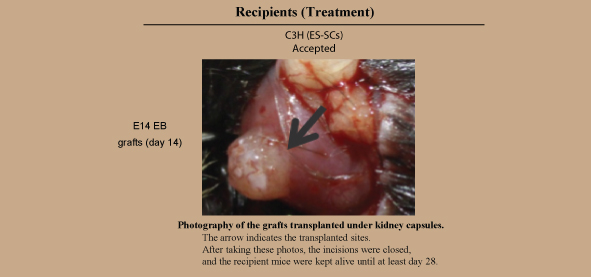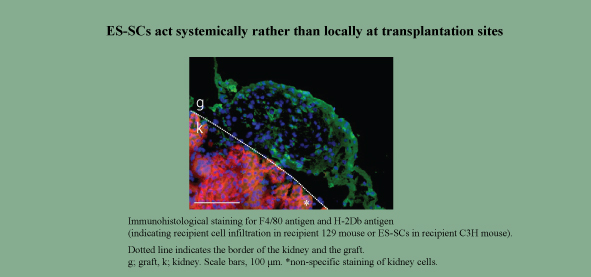Rejection Response Successfully Suppressed by ES Cell Differentiation Induced Immunosuppressive Cells —a new immunological suppression method using pluripotent stem cells in future regenerative medicine proposed
Research Press Release | December 01, 2014
-
 Photography of the grafts transplanted under kidney capsules.
Photography of the grafts transplanted under kidney capsules. -
 ES-SCs act systematically rather than locally at transportation sites.
ES-SCs act systematically rather than locally at transportation sites.
| Press Release | ||
|---|---|---|
| Key Points |
・Grafts and immunosuppressive cells were prepared from ES cells for use in regenerative medicine. ・Rejection reaction was successfully suppressed by pretreatment with ES cell derived immunosuppressive cells before graft implantation. ・A method to overcome issues predicted in the future regenerative medicine using ES cells and iPS cells is proposed |
|
| Overview |
Pluripotent stem cells such as ES cells and iPS cells can be differentiated into various types of cells and their application in regenerative medicine is highly expected. When organs and cells are transplanted from another person, rejection occurs due to the body’s immune activity and they are discharged from the body. To avoid rejection, it is important to suppress the immune system. This also applies to the transplantation of cells and tissues derived from pluripotent stem cells. Special research student Hiroya Kudo, Lecturer Haruka Wada, and Professor Ken-ichiro Seino of the Division of Immunobiology, Institute for Genetic Medicine proposed and verified an immunological suppression method necessary for future regenerative medicine which uses cells and tissues derived from pluripotent stem cells in medical transplantation. The research group prepared two kinds of cells derived from mouse ES cells: cells (grafts) for use in regenerative medicine and cells which can suppress the immune system. The group then developed a method to suppress the rejection reaction in transplants from one body to another. By implanting immunosuppressive cells prior to graft implantation from one mouse to another, the group succeeded in extending the period of engraftment (the length of time when the graft could remain in-vivo without rejection). |
|
| Inquiries |
Ken-ichiro Seino, Professor, Division of Immunobiology, Institute for Genetic Medicine, Hokkaido University TEL: +81-11-706-5531 FAX: +81-11-706-7545 E-mail: seino@igm.hokudai.ac.jp |
|
|
Japanese Link |
ES 細胞から分化誘導した免疫抑制細胞により拒絶反応を抑えることに成功~多能性幹細胞を用いるこれからの再生医療時代における新しい免疫制御法を提案~ | |
| Publications | Induction of Macrophage-Like Immunosuppressive Cells from Mouse ES Cells That Contribute to Prolong Allogeneic Graft Survival (PLoS ONE, 2014.10.30) | |
